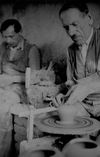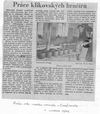|
Brief history of the pottery in Klikov
The boom of the production of ceramics in Klikov and surrounding villages in the second half of 19th Century was related to a gradual decline in production in so called soft pottery. Better quality stoneware, which was fired to a much lower temperature, began to replace older pottery products
The German family Klaus brought new production technology to Bohemia. They made their high temperature wood-fired goods in Prague since 1850. They later worked in Zbraslav, Bechyně and since 1883 in Staňkov. From there the method of production moved to Klikov. Some experienced potters, who worked in established workshops producing soft pottery (Ledenice, Bukovsko, Vltavotýnsko and others), moved to the area at the same time.
Potters were attracted by local clay, which allowed production of lasting and much sought after goods. The sales of so called “stoneware crockery” were extensive. Other workshops were being established in surrounding villages (Tušť, Hamr, Suchdol and Chlum). Rustic brown pottery was mainly being made and also white and decorated tableware. They made pots, jugs, bowls, drip pans, moulds for marble cakes, Easter lambs, barrels for cabbage, flowerpots and many other products. The workshops couldn’t satisfy demand.
After the First World War came decline in sales, which was caused by the
increase in production of tin and porcelain and by the change in lifestyle.
At that time many workshops all over the Czech republic disappeared. The ones that survived transformed in time into modern ceramic manufactures.
Many of the workshops in Klikov were producing successfully until their nationalisation. From the original 12 workshops in Klikov only three are fully functional today. They are still firing using live wood fire in a brick walk-in kiln.
|





click to enlarge
|
|





